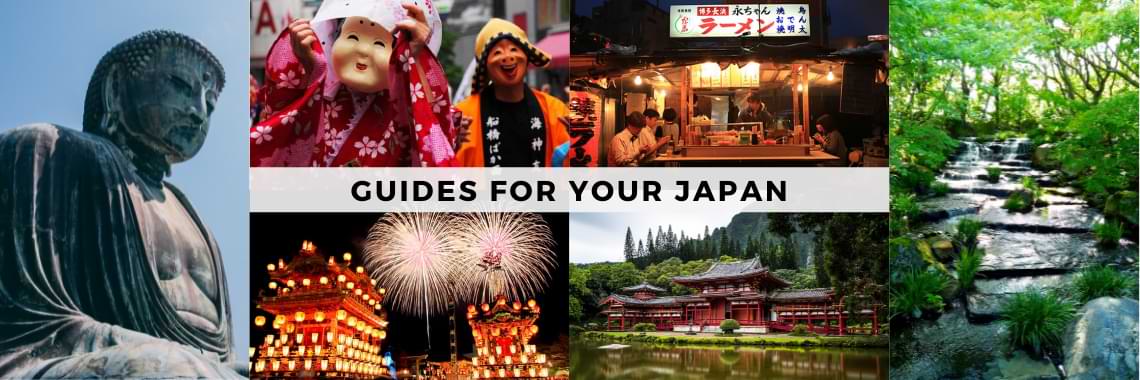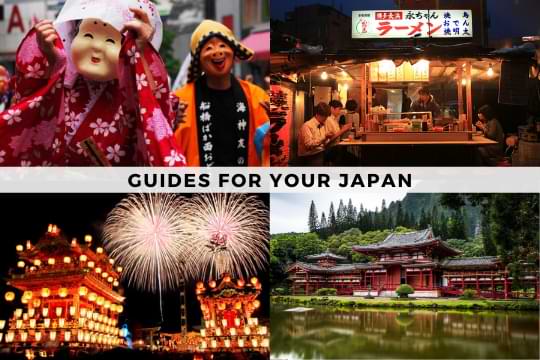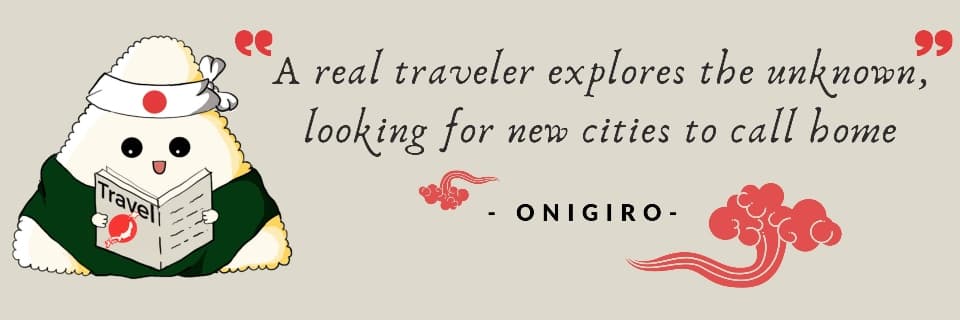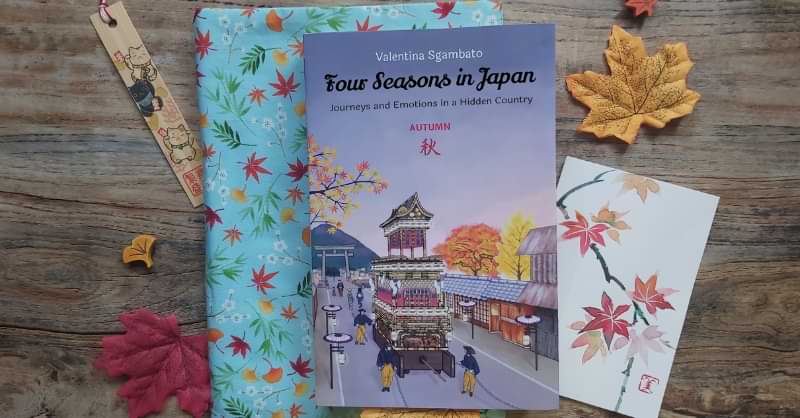Japan travel guides
Always bring our Japan travel guides to know the best things to do and plan a your perfect trip to Japan!


Websites are full of information, but 90% of them are always on the same few topics: things to do in Tōkyō, which temples to visit in Kyōto or what food to try in Ōsaka.
Instead, Onigiro will take you to discover the cities off the beaten track where you can get to know the real Japan!

Since information about small cities are hard to find, also because websites are often in Japanese language, in this section we have gathered the best festivals, points of interest, foods and much more inside our Japan travel guides, one for each of the 47 prefectures (to date there are 5 prefecture guides available).
Hokkaidō & Tōhoku | Kantō | Chūbu | Kansai | Chūgoku | Shikoku | Okinawa & Kyūshū
Planning your own itinerary is one of the best parts of the journey, full of expectations and emotions, and Onigiro is here to help you with your planning!
All our Japan travel guides have the same 7 sections structure, each of them explained in details in the following. In this way, you’ll be able to easily read them both while planning your itinerary from computer and during your travel in Japan on smartphone or tablet. If you have any question, do not hesitate to contact us.
1 - Festival, fireworks & other Japanese events
The first section of our Japan travel guides is dedicated to festivals and other Japanese events, both religious, related to Shintoism and Buddhism, and popular, like fireworks and illuminations.
For every prefecture and main cities we’ll provide you detailed information about the events with pictures, dates, description and location of the event itself.
Festival calendar
Depending on the season, there are different types of festivals in Japan. Let’s see the main categories:
- January – during the first week of each year, every Japanese city celebrates Hatsumōde, the first visit to shrines and temples praying for the new year;
- February – northern part of Japan is covered by amazing powder snow and many snow festivals are held in this period;
- March ~ April – Spring is in full bloom and Japanese simply cannot wait to enjoy the Golden Week vacations organizing pic-nics with family and friends under a pink cherry sky;
- July – in many cities there are summer fireworks display every weekend, with national competitions taking place in some of them;
- August – this month hosts the Obon period, the main Buddhist festivity, celebrated with folk dance festivals, lantern shows and fireworks;
- September ~ October – different types of celebrations are held in many cities to obtain benevolence from Kami, the deities of Shintoism, and pray them for a good rice harvest;
- November ~ December – cities fires up with illumination events for autumn leaves and decoration for Christmas.
Seems like that every month is worth a visit, isn’t it? And there are also many other national and local festival to attend! Keep an eye on Onigiro’s blog to know more.
Mind the date
Some yearly recurring events are easy to plan on your itinerary because they have fixed dates, like the Takayama Autumn Matsuri that takes place on 9 and 10 October every year.
However, a lot of events have dates changing every year, like the Nagoya Domannaka Matsuri that is scheduled on the second half of August, for example 22~25 August in 2019 and 27~30 August in 2020.
Inside the first section of our Japan travel guides we have sorted the most important festivals of the prefecture and the corresponding main city with past dates, schedules, official websites and event description. With all these information, how can you miss the fun?!
2 - Japan travel guide to the best things to do
Japan has loads of different activities, essential while planning an itinerary. Among them you’ll find castles, Buddhist temples, Shinto shrines, breathtaking gardens and many other cultural heritage sites.
TripAdvisor already has an extensive list of places with thousands of reviews, very useful to have general information on other traveler’s experiences but poor of information on best period to visit or events going on in the area. Also, those places might be very crowded because everyone go to see the same “top 3 things to do in …” on TripAdvisor.
And that’s the added value of this second section of our Japan travel guides: for every prefecture we give you the best point of interests with pictures, description, local events, unique activities and Google Maps navigation tips to ease your online experience. Lastly, we’ll add some hidden gems that many websites does not even know about!
3 - Local food to taste
Everyone loves food, and Japanese cuisine is one of the most delicious on earth. While traveling, trying unique food is Onigiro’s favorite activity, always hunting for local cuisine!
Many regions and cities have their own version of a specific meal: for example, a bowl of rāmen differs a lot between Fukuoka’s tonkotsu rāmen and Hokkaidō miso rāmen.
Inside this section of our Japan city guides, we present each food you should try when visiting a destination, with interesting insights and information on ingredients that might not be so clear.
Japanese most famous restaurants are easy to find on internet, always located around central stations and malls. But what will increase your travel experience are small family shops far from the beaten paths. Onigiro will bring you there, where a warm Japanese family will cook a delicious and restorative meal while trying to speak with you with a shy and basic English.
4 - Japan travel guide to typical souvenirs
When visiting a city, we’re always busy running between points of interest and time runs out quickly. But at the end of the day everyone wants something, other than pictures, to remember the city.
So the most of us ends up picking poor quality magnets with a printed picture of the city for our refrigerator… but Onigiro can help you! Instead of a magnet, every city has something unique that you can bring home as souvenir, like an indigo painted cloth, a small wood crafted animal or some local potteries!
For every city, we’ll suggest what you can bring home as souvenir, why it’s so special and where to buy it so you don’t have to lose time looking for it interrupting your itinerary.
5 - Nearby destinations to add to your itinerary
There are two types of travelers, the ones that plan everything in advance with a detailed day-by-day itinerary, and the adventurous ones that decide where to go daily.
In both cases, you’ll find this section helpful: for every city we’ll provide you the closest interesting places that you can add to the journey. We know that planning an itinerary is a time consuming activity, but Onigiro will make you save a lot of time!
6 - How to move between cities and within cities
Planning how to travel between and inside cities is always a good idea, especially if it’s your first time in Japan. Inside big cities, it’s easy to move with subways, but on countryside you have to use buses and local trains.
Inside this section we share with you the best way to visit every Japanese city and how to get there from nearby cities.
Moving between cities
Japanese trains are very comfortable connecting thousands of cities, and with JR Pass they’re also convenient as a tourist. But sometime small cities aren’t served with trains: Kusatsu Onsen, for example, is a famous hot spring town close to Tōkyō but hard to visit since you need two trains to reach Gumma-Ōtsu station and then a bus for Kusatsu Onsen.
Inside our Japan travel guides, all those information are provided with ticket price, connection times and much more, because we too were tourists for the first time and we certainly didn’t know the Japanese language.
Renting a car to visit Japan is a great idea if you’re used to left-hand traffic, because rural areas are wonderful but hard to reach with buses…
Moving withing the city
Subways are available only in some big cities, like Tōkyō, Ōsaka and Nagoya, but in smaller ones is more common to take buses or local trains.
Taxis are the most comfortable transportation method, convenient for groups of 3 or 4 people but expensive for solo travelers. In front of every main train station there are always a bunch of them available, so if you need them you know where to find them!
Buses are cheap and always on time, use them to explore the city in a relaxed way among the locals during their daily lives.
Renting a bicycle is a great idea, but not common among tourists because bike-sharing systems are often only in Japanese language. Alternatively you can go for local rental-bike shops, but you have to know where they are and Onigiro is here to help you!
| Onigiro advice | Once arriving at tourist service center, ask for bus and train maps: especially in big cities like Kyōto is always a good idea to have a city lines map to follow alongside Google Maps.
7 - Example travel itinerary
In the last section of our Japan travel guides you’ll find Onigiro’s original 1 or 2 days itinerary to visit the area, with details on connections and points of interest.
We hope this section will inspire anyone who is planning a journey in Japan. Do not esitate to contact us if you need additional information and tips on Japanese destinations!



